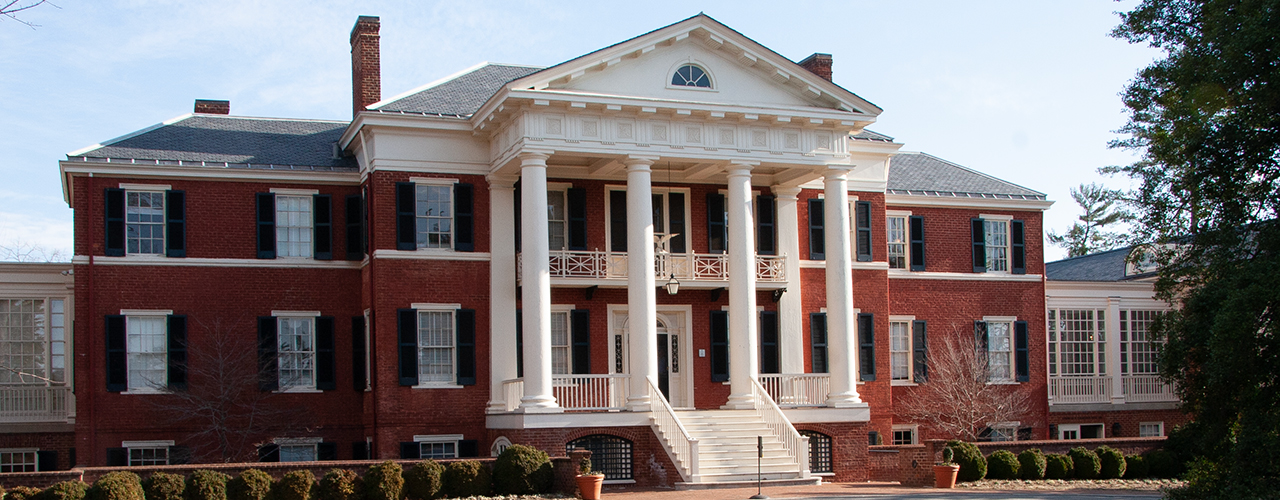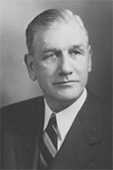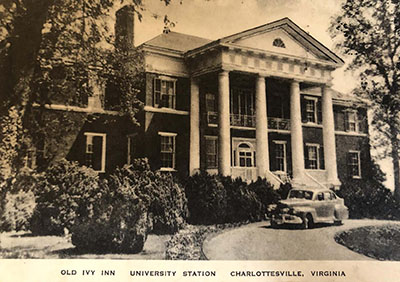History of the Faulkner House

The Faulkner House has been home to the Miller Center of Public Affairs since 1975. The building sits a mile west of the University of Virginia; the Miller Center is an affiliate of the University, endowed by UVA alum Burkett Miller in honor of his father, White Burkett Miller.
Construction of the House
In 1854, Addison Maupin purchased the land from the estate of Jesse Pitman Lewis – Lewis was a soldier during the Revolutionary War. Maupin was a hotelkeeper at the University at the time the land was purchased; his brother Socrates Maupin was a chemistry professor and former student at UVA. Two years later, in 1856, the construction of the house was completed.
 There is little record of the actual construction of the house, notably whether enslaved laborers owned by the Maupin family built it. There is reason to believe that Addison Maupin was a slaveowner at the time the house was built. Correspondence between the two Maupin brothers indicates that, in December 1847, Socrates Maupin sold an enslaved man named William and his two sons to Addison Maupin. There is also record of a public auction for two enslaved children, held by the estate of Addison’s daughter, Lucy Maupin. Further, early histories of Charlottesville and UVA indicate that it was common for most University faculty to own slaves. In John Moore’s Albemarle: Jefferson’s County, 1727-1979, it is noted that “Addison Maupin … had a dozen [enslaved laborers].”
There is little record of the actual construction of the house, notably whether enslaved laborers owned by the Maupin family built it. There is reason to believe that Addison Maupin was a slaveowner at the time the house was built. Correspondence between the two Maupin brothers indicates that, in December 1847, Socrates Maupin sold an enslaved man named William and his two sons to Addison Maupin. There is also record of a public auction for two enslaved children, held by the estate of Addison’s daughter, Lucy Maupin. Further, early histories of Charlottesville and UVA indicate that it was common for most University faculty to own slaves. In John Moore’s Albemarle: Jefferson’s County, 1727-1979, it is noted that “Addison Maupin … had a dozen [enslaved laborers].”
The Civil War Years
During the Civil War, the Jurey family owned the Faulkner House. Histories of the house and accounts from Charlottesville during that period suggest that two women operated the house, which briefly housed Union General Thomas Devin and several Union soldiers.
The Faulkner House was passed through a series of owners throughout the late 19th century. Charles Goodyear, a judge and politician from New York, purchased the house in 1869 after retiring from the U.S. House of Representatives.
Senator Thomas S. Martin
 In 1906, Thomas S. Martin, a U.S. Senator from Virginia (1895-1919), purchased the house and named it “Montesano.” He hired architect Waddy B. Wood to enlarge and remodel the house; the current design and architecture of the Faulkner House stems from this 1907 renovation. This includes the front portico, as well as the original wing additions on either side of the house.
In 1906, Thomas S. Martin, a U.S. Senator from Virginia (1895-1919), purchased the house and named it “Montesano.” He hired architect Waddy B. Wood to enlarge and remodel the house; the current design and architecture of the Faulkner House stems from this 1907 renovation. This includes the front portico, as well as the original wing additions on either side of the house.
Martin was an incredibly powerful politician – not just in the Virginia Democratic Party, but in the Senate. His party organization was the foundation of the “Byrd Machine,” named after Harry Byrd, the most powerful political force in Virginia politics throughout the 20th century. Martin had two children, Thomas Martin Jr. and Lucy Day Martin. There was some confusion as to the ownership of the property after Martin’s death. The house was left to both Martin children; according to state records, there was a case in the Albemarle Circuit Court (Lucy Day Martin v Thomas S. Martin Jr., recorded in Deed Book 175, Page 337) in which the plot land was divided between the two Martin children. The entirety of the property was then sold to Frederick Lewis in 1920.
Governor John S. Battle
 From 1923 to 1932, John S. Battle owned and occupied the house. Battle, a UVA alum and governor of Virginia (1950-1954), has not been included in past histories of the house. His purchase of the property, however, is recorded in Albemarle County records. While residing in Charlottesville, Battle served in the Virginia State Assembly. Like Senator Martin, Battle was a part of the Byrd Machine and worked closely with Harry Byrd. He was a segregationist and did not support integrating Virginia's public schools when he was governor. Despite this stance, President Dwight Eisenhower appointed Battle to the U.S. Commission on Civil Rights in 1957 because he wanted southern views to be represented on the panel.
From 1923 to 1932, John S. Battle owned and occupied the house. Battle, a UVA alum and governor of Virginia (1950-1954), has not been included in past histories of the house. His purchase of the property, however, is recorded in Albemarle County records. While residing in Charlottesville, Battle served in the Virginia State Assembly. Like Senator Martin, Battle was a part of the Byrd Machine and worked closely with Harry Byrd. He was a segregationist and did not support integrating Virginia's public schools when he was governor. Despite this stance, President Dwight Eisenhower appointed Battle to the U.S. Commission on Civil Rights in 1957 because he wanted southern views to be represented on the panel.
It is notable that Governor Battle was a previous owner of the property, given that his family, including his son, Ambassador William C. Battle, have been actively involved with the Miller Center for many years.
The Inn and UVA
 In 1946, Noble Macfarlane bought the house and opened the Old Ivy Inn. The University of Virginia acquired the property in 1963 and initially used it as a guest house. It was later used as an office space for the Darden School of Business and the Tayloe Murphy Institute.
In 1946, Noble Macfarlane bought the house and opened the Old Ivy Inn. The University of Virginia acquired the property in 1963 and initially used it as a guest house. It was later used as an office space for the Darden School of Business and the Tayloe Murphy Institute.
The Miller Center moved into the Faulkner House in 1975. Although the building was named for novelist William Faulkner, who was a writer-in-residence at UVA in 1957, he never actually lived in the house. In 1989, the Center added the Newman Pavilion, which houses the Forum Room, and in 2003 it built the Thompson Pavilion and Scripps Library. The additions are prominent examples of new traditional architecture. Today the Miller Center occupies more than 15,000 square feet of space.
